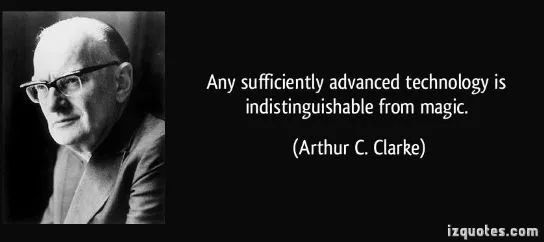
Artificial Intelligence Will Not Fix Workers’ Compensation Claims Handling
January 13, 2022 – Michael Marsh
Strong statement in the face of hundreds of articles and marketing 'white papers': Artificial Intelligence enabled software and/or applications WILL NOT solve the issues currently evidenced in the practice of handling/administering workers compensation claims.
I receive so many sales pitches by telephone and e-mail. The nice Sales Executives (or more often than not young prospectors attempting to set up a virtual meeting for their sales person) are selling the next generation of AI in a new 'never been seen by human kind' enabled app. The optimism for the power of the tools being offered is palpable.
With very little knowledge of our operation or needs, I get to hear how their software will bring to our company more predictable results, stronger loyalty with current customers and marketing advantages over our competitors. Some type of magic potion. At times during the week, I feel like I'm looking at the back of a covered wagon and the man standing on the back gate has the oil that will cure snake bites. Or perhaps more accurately, a train of wagons circling around prospective customers, each with a different AI oil available for the prospect in need.
It is true to say that the workers' compensation claims industry is faced with some significant challenges, some of which are:
- Current staffing shortages in professional and support positions
- Post-pandemic management of hybrid and fully work-from-home adjusters/examiners
- Future staffing challenges and knowledge loss via The Great Retirement
- An empty prospect pipeline caused in part by young people's apparent lack of interest in insurance claims as an occupation
- Few college level training programs for students to be exposed to and become interested in workers' compensation claims
But we've seen this wave before in the claims industry. AI cannot and will not 'fix' the lack of human beings entering the workers' compensation claims industry. Even a close evaluation of the coding, the computer, the interface or the 'magic' is simply a substitution of time and effort. Workers' compensation is a human helping human business. AI is one of many tools in the adjuster's toolkit.

I’m less concerned about the near term death of all humans at the hand of awake machines than some others. Machine learning (or AI) is essentially a series of algorithms that get input and then present results to users just as they are told to do by their programmers. My lessened fear of machine learning / AI is not so much about the machines…except for some misbehaving apps from the state of Washington, (recall the blue screen of death in the XP days?) the machines do what they are told to do, when they are told to do so, by their “masters”.
My confidence of the survival of the human race with respect to AI is rooted in the inability of most humans to think/evaluate/program the machines to think in the sophisticated way that the human brain works. Humans are generally opposite of simplistic Yes/No switches. We understand gray areas, innuendo, rumor and body language. Machines don’t and at this point cannot. Machines are simply X's and O's, Yes or No, On or Off. Creating algorithms sufficiently sophisticated to tie together thousands, if not millions, of Yes and No responses is simply beyond our ability to understand and program at this point in human history.
Around 1992, when we began using a personal computer seriously, using this new miracle software (spreadsheet) and data from the mainframe, we were able to begin building a predictive model of claims costs. Without a huge scope document sent to those strange men and women in that locked room way back there we could begin studying our numbers. Now. Not in 6 – 9 months waiting for a new report to come out of COBOL-land. Now. People learning about the business…using machines.
It was a positive time, optimism about how computers would help revolutionize the insurance claims industry. There was always talk of how the predictive modeling was going to obviate the need to do case reserves on claims. We heard, if we have the type of injury, the severity, the treatment codes, we’ll know within xx% (insert your own low number, cause the predictors were all wrong). They continued that we'd know total incurred with a high level of certainty what the book of business will cost by state. Just a few reports from the data in the system and we’d know what next year’s rates would be…no longer dependent upon those distasteful people back in the Claims Department. Underwriting, Loss Control, Compliance, Actuarial,Accounting…seemed like everyone shared the vision of a group of automatons in the claims are The computer will let us hire less of those people and we’ll have better, more timely information and none of those last minute, pre-trial reserve evaluations. Investors and shareholders were very optimistic. The AI machines will guide us.
They were wrong.
It has been a couple of decades of promises, optimism and hope for Artificial Intelligence to rescue the industry. Have there been some moderate efficiency improvements? Of course. Most insurance companies and TPAs I speak with echo that sentiment. But let’s be honest. There hasn’t been that much investment in AI. Much of the industry has been trying to figure out how to more effectively and effectively pass claims and overhead fixed costs on to the customer in the ever-increasing rates.
For at least 10 years companies have been moving to the work-from-home claims model. This has picked up steam and much press coverage with the COVID crisis of 2019. What is the work-from-home motivation? Some say it is to achieve better service levels, develop closer and productive relationships between the adjuster/examiner and the recovering worker and the treating legitimately injured workers with respect and dignity. Others are fixated on being able to hire a new generation of computer operator adjusters who will only work claims from their homes...never to meet or shake the hand of a recovering worker or a grieving surviving spouse.
My take on it for years has been that work-from-home is a desire to simply reduce fixed costs. My company experimented with work-from-home back more than a decade ago. As a small, single state TPA, we were able to watch the results closely and have a strong confidence level that we were controlling variables. We had a number of issues, scan quality, internet access speeds and supervision.
Fortunately in the many years that have passed, imaging has improved and the costs have come down sufficiently that paper can actually and efficiently be changed to digital images to allow people to work at home in their jammies. The feedback we are getting solidifies the results we had 10 years ago. The strength of the relationship between the recovering worker and their adjuster/examiner lessens in the virtual environment when contrasted against face-to-face. Industry numbers are more difficult to compare. Will the overall financial results suffer as we witnessed?
Managing the non-face-to-face process has certain challenges. What happens when the incoming mail indexing is incorrect, images are lost or attached to the wrong claim, misdirected or damaged? How much resource is spent ensuring correct indexing, researching anomalous conditions, etc? Are those resources accounted for when evaluating the overall effectiveness of the non-face-to-face process? That topic is for another day.
At least for now, workers' compensation remains a human helping human business.

If and when you are in a position to consider the "next greatest software that is going to change your worklife" pitch, consider asking (as I do): is the ‘off the shelf’ AI software presented now sufficiently sophisticated to:
- help you identify the right provider for a case and steer the injured worker to that provider,
- establish first year reserves that will keep reserve development within 5% over a ten year period,
- help the indexing of incoming mail, bills, text messages, e-mail and faxes process for an individual with multiple open claims,
- help busy adjusters easily spot potentially troublesome cases and manage them more effectively, from start to finish, and
- continuously optimize your network of providers, so you can be sure to have the right provider working with the right recovering worker at the right time?
After many external claims audits of our work, my appearance in extra-contractual litigation as a claims process expert and reviewing tens of thousands of workers’ compensation claims, my experience has been that the best predictor of a claim resolution is an experienced adjuster/examiner that:
- is empowered to make claims and financial decisions,
- knows their jurisdiction well,
- has strong administrative and systems support, and
- has a low ongoing case load.
Takeaway:
Enable your adjusters and examiners to obtain information and make decisions. Empower your adjusters, examiners and supervisory staff to bend the rules if it will help a worker recover faster or more completely. Resist tearing down your adjusters and supervisors for not following the 'rules' or 'guidelines' ... especially when they made the right decision.
And for software sales encounters: Buyer Beware
Addendum
Shortly after this article was published, FastCompany published an article about ChatGPT. ChatGPT is an artifical intelligence engine that is being tested for content generation (writing articles or e-mails for the user). I found it interesting that the writer Rob Locascio used the same Arthur C Clarke quote as appears at the opening of this article.
Locascio seems to support the concept, consistent with my opinion, that AI may not yet be ready for prime time. Read the article @ https://www.fastcompany.com/90844120/i-tried-using-chatgpt-to-write-this-article .
